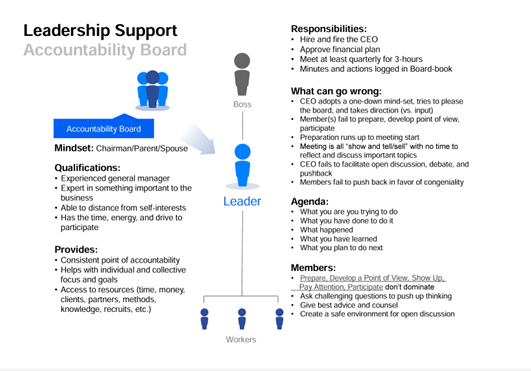Growing private companies often encounter challenges in establishing an effective board of directors. Typically, boards comprise well-meaning individuals who meet periodically, usually for a few hours up to a couple of days. However, these meetings frequently become sessions to celebrate company successes rather than critically examining company performance against its board-approved plans and strategic initiatives for the year.
For these companies, it’s vital to have a diverse board, including external directors who offer unbiased insights and prevent family / founder / owner dominance. Establishing clear governance policies and procedures is essential, as they define the roles and responsibilities of each board member. Moreover, regular board meetings focused on progress towards strategic goals, rather than on operating details, are crucial.
This post outlines best practices for efficient private company board meetings, ensuring that your time together is well-spent. We also provide a template for an effective board meeting agenda.
The Board Agenda – Your Roadmap to Efficiency
Preparation is Key
- The board chair should distribute a draft agenda 4-5 days before the meeting, soliciting upgrades and additional topics.
- Agendas must be clear, concise, and focused on performance metrics, strategic goals, and pressing issues.
Best Practices for Productive Meetings
- Limit meetings to three hours to maintain focus and energy.
- Introduce new items for information only, with decisions deferred to subsequent meetings after thoughtful review.
- Distribute materials a day or two in advance, allowing members to come prepared.
- Allocate time for informal interaction before and after the meeting to foster trust and collaboration.
- Record and distribute key action items, decisions, and insights promptly after the meeting.
Agenda Template
- 10-min: Administrative matters (e.g., by-law updates, approve minutes from prior meeting, etc.)
- 15-min: CEO’s overview of the business state
- 20-min: Financial performance review of actual results vs. plan and projections
- 20–40-min/ea: Updates and discussion of strategic initiatives (up to three) and / or committee (e.g., compensation committee, governance committee, audit committee) reports
- 10-20-min: New or walk-on items
- 5-20-min: Future meeting topics
- 5-min: Adjournment and reminders of meeting Action Items, Decisions, and Insights
This template is flexible and can be adjusted to fit the unique needs of your board.
Conclusion
Setting up and managing an efficient board for fast-growing private companies is both challenging and rewarding. By adopting these best practices and using a structured agenda, boards can offer valuable guidance and oversight, enhancing their collaboration with the management team.
See Also
- A Practical Guide to Building and Running a High-Performing Board
- Creating a High-Performing Board of Directors for Private Companies
- How to Create an Effective Board for your Company
- How to Run a Board Meeting
- How Long is Too Short for a Meeting

About The Author
 David Halwig, IntelliVen Co-Founder and President of Mid-Atlantic Region, provides strategic management consulting and advisory services to leaders whose organizations are at critical inflection points. David helps improve governance, leader development, strategic planning, and risk management. He also has substantial experience with merger and acquisition strategies, valuation, and transition approaches.
David Halwig, IntelliVen Co-Founder and President of Mid-Atlantic Region, provides strategic management consulting and advisory services to leaders whose organizations are at critical inflection points. David helps improve governance, leader development, strategic planning, and risk management. He also has substantial experience with merger and acquisition strategies, valuation, and transition approaches.

